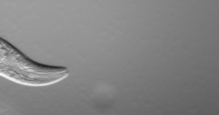 The sciatic nerve is a critical branch of the central nervous system. It connects the legs to the dorsal root nerve, which then connects to the spinal cord. The sciatic nerve is crucial to everyday movement and sensation and is the largest nerve in the body. Here are some highly magnified images from sciatic nerve. This tissue was taken from a mouse, but looks similar in humans and other mammals. The nerve itself is composed of small bundles called Axons (see image right, click to enlarge). Each of these bundles is wrapped a membrane-like material called Myelin, or the Myelin Sheath. The Myelin, made by a specific cell called a Schwan Cell, is crucial to conducting electrical impulses that travel through the nerve (there are two Schwan cells visable on the left side of the right image). The image on the left shows the different layers of myelin as they wrap around the axon (click to enlarge).
The sciatic nerve is a critical branch of the central nervous system. It connects the legs to the dorsal root nerve, which then connects to the spinal cord. The sciatic nerve is crucial to everyday movement and sensation and is the largest nerve in the body. Here are some highly magnified images from sciatic nerve. This tissue was taken from a mouse, but looks similar in humans and other mammals. The nerve itself is composed of small bundles called Axons (see image right, click to enlarge). Each of these bundles is wrapped a membrane-like material called Myelin, or the Myelin Sheath. The Myelin, made by a specific cell called a Schwan Cell, is crucial to conducting electrical impulses that travel through the nerve (there are two Schwan cells visable on the left side of the right image). The image on the left shows the different layers of myelin as they wrap around the axon (click to enlarge). Multiple Sclerosis (MS) degrades the Myelin Sheath, interfering with signaling. MS can result in a plethora of debilitating neurological problems ranging from muscle weakness to speech problems.
Multiple Sclerosis (MS) degrades the Myelin Sheath, interfering with signaling. MS can result in a plethora of debilitating neurological problems ranging from muscle weakness to speech problems.This sample was provided by Hasna Baloui of the Salzer lab in the Smilow Institute of the NYU School of Medicine Neurology Department. The images were gathered on a Philips CM-12 TEM.





-13b.png)
-13.png)



















